Samsung Galaxy S 2 (International) Review - The Best, Redefined
by Brian Klug & Anand Lal Shimpi on September 11, 2011 11:06 AM EST- Posted in
- Smartphones
- Samsung
- Galaxy S II
- Exynos
- Mobile
The other part of the story is Samsung’s mobile Digital Natural Image engine, or mDNIe, profile set on the SGS2. Numerous people have noticed that under Display -> Background Effect, lurks a page with a sample image and three presets - Dynamic, Standard, and Movie.
On previous Galaxy S devices there was a box in the camera app marked ‘outdoor viewing’ which increased brightness and contrast. I always wondered how that worked, and the answer is through mDNIe profiles. Inside /system/etc/ are a bunch of files prefixed with ‘mdnie_tune’ and then some more text, for example ‘mdnie_tune_camera_outdoor_mode’ and ‘mdnie_tune_standard_mode’. Of course, these are how the various settings are defined, and there are a bunch of them.
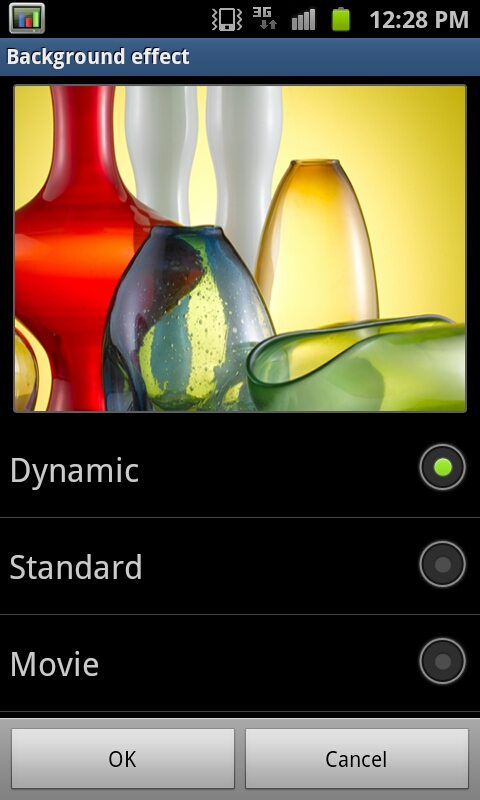
Inside are settings which control sharpening, saturation, and other things which are governed by mDNIe. For example, the mdnie_tune_ui_standard_mode file looks like this:
//start 0x0001,0x0000, // 0x002c,0x0fff, //DNR bypass 0x003C 0x002d,0x1900, //DNR bypass 0x0a08 0x002e,0x0000, //DNR bypass 0x1010 0x002f,0x0fff, //DNR bypass 0x0400 0x003A,0x000d, //HDTR DE_off CS : de on = d , de off = 9 0x003B,0x0001, //DE SHARPNESS(0~1023) off 0x003C,0x0000, //NOISE LEVEL 0x003F,0x001e, //CS GAIN 30 0x0042,0x0030, //DE TH (MAX DIFF) 0x0028,0x0000, //Register Mask //end
Movie and Standard just differ in CS (Chroma Saturation) Gain (from 30 to 50), and dynamic boosts that to 300 along with another field whose purpose I’m not certain of. I’m told by Francois that Dynamic also changes white point through mDNIe by clamping and thus results in some dynamic range being lost. Unfortunately there’s no - everything off - mode with no sharpening or chroma gain that makes colors less oversaturated out of the box, though if you have root obviously you can change and experiment with these. Now that we’ve mentioned it, all measurements I’ve done on the SGS2 were in the Standard mode.
Now what about brightness across the spectrum of user-selected intensity percentages?
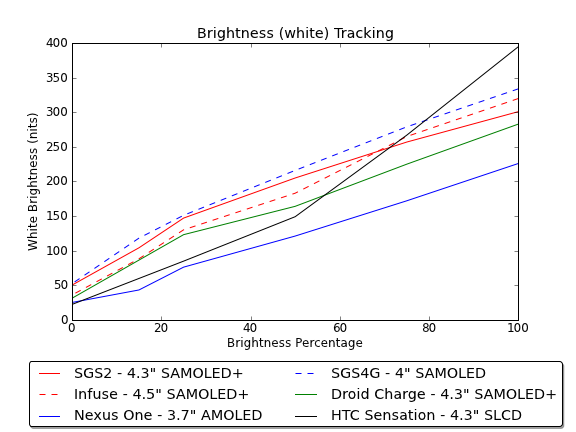
It’s redundant to show black brightness since each device measures 0 nits due to black pixels not emitting any light, so AMOLED remains super contrasty, even if brightness is about the same with SAMOLED+ as it was with SAMOLED. Thankfully the curve is nice and linear.
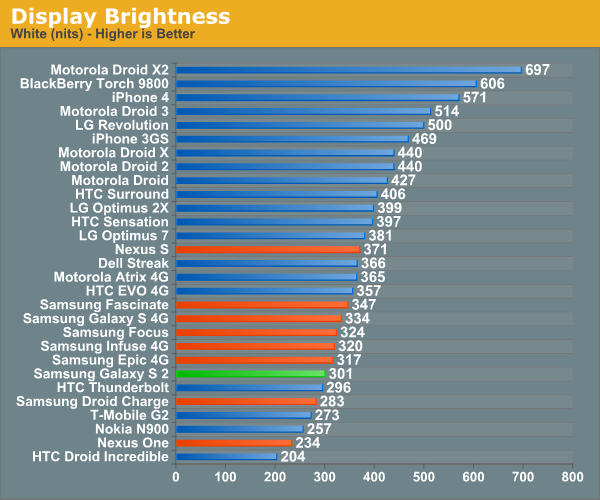
On the big display graph though, SAMOLED+ still isn’t as bright as the competition, though again having infinite contrast does make the display subjectively awesome indoors.
Outdoors SAMOLED+ is about the same as the previous generation. It isn’t very easy to see the display contents outside in direct sunlight, but then again what phone does look as good outside as it does inside? SAMOLED+ as mentioned earlier still leverages the optical bonding benefits (fewer reflections) that SAMOLED brought, so if you were pleased with view-ability there expect much of the same with this update.
The only major issue outdoors is something else entirely. I noticed pretty quickly with the Infuse 4G and Droid Charge that outside in my climate’s environment (~100+F outdoor temps, lots of sunlight) that the phones would clamp brightness to about 75% to prevent overheating. This is in part a measure to protect the display panel and of course other internal components. I set out to find out whether SGS2 implements the same thermal restrictions, and it does.
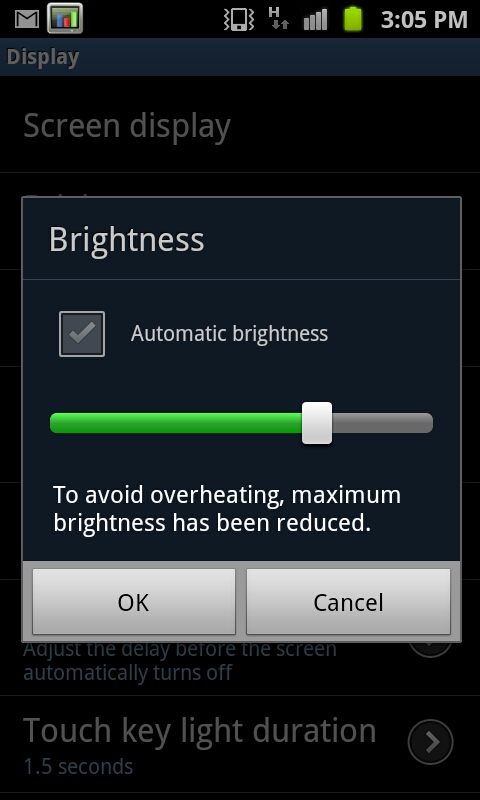
I broke out my contactless IR thermometer and went outside into the midday sun on my patio and set the phone down. Overheating and clamping down the display brightness doesn’t take long in this climate, about 5–10 minutes will do it. At around 115F (~45C) surface display temperature you’ll get clamped to 75% maximum until temperature drops down. I actually subjectively don’t think SGS2 is as prone to overheating as the Charge or Infuse.
Some other people have reported SGS2 crashing or encountering a thermal shutoff after a certain point, so I braved the heat and stayed outside even longer using the device until it hit well over 140F (60C) and still no system shutdown or overheating happened. That’s not to say it isn’t possible, as the SGS2 clearly does have thermal monitoring, for example the following lines from dmesg suggest some thermal monitoring going on, though I definitely crossed these boundaries to no ill effects:
<6>[ 0.047638] thr_low: 83, thr_high: 98 warn_low: 97 c warn_high 106 <6>[ 0.047715] tq0_signal_handle_init <6>[ 0.047751] tmu_initialize: te_temp = 0x00000048, low 8bit = 72,high 24 bit = 0 <6>[ 0.047765] Compensated Threshold: 0x7d <6>[ 0.098087] Cooling: 82c THD_TEMP:0x80: TRIG_LEV0: 0x89TRIG_LEV1: 0x99 TRIG_LEV2: 0xa0
Back to the display, next up are viewing angles, which the SGS2 thankfully preserves from the previous generation. I tossed the SGS2, SGS4G, and Optimus 2X in the lightbox and took pictures at various extreme angles. I realize the Sensation is a comparison point people are interested in, unfortunately that went back a while ago.
Viewing angles are awesome on all three - the SGS4G’s SAMOLED display (left), SGS2’s SAMOLED+ (middle), and Optimus 2X’s IPS display (right).
Another small thing about the SGS2’s SAMOLED+ is that I’ve noticed that high contrast images can be persistent for a few seconds. It isn’t burn-in, but a persistence that stays for a few seconds and can be very visible. For example, leaving the Android keyboard up (which is black, grey, and white) and dragging the shade down, a shadow of the keyboard remains visible until it fades after a few seconds. This persists even on other applications as well, and I can only hope doesn’t become something permanent if left up too long.
Wrapping up SAMOLED+ is difficult, because whether or not you like it over traditional LCD alternatives is ultimately a very subjective (and as I’ve learned in discussions, sensitive) matter. We’ve codified the differences between SAMOLED+ and previous generations, and other IPS displays, but really it’s impossible to communicate every subtle difference.
Personally, I prefer higher PPI IPS-LCD displays, though at 4.3“ SAMOLED+’s WVGA (800x480) isn’t a slouch, and the change from RGBG PenTile to an RGB stripe helps matters. Where WVGA starts to become a problem is at 4.5”. Scaling up area and increasing the diagonal size by 0.2“ doesn’t sound like a problem, but r^2 is a bitch, and at that size both the Android UI elements and subpixels look absurdly huge. Luckily, the international SGS2’s 4.3” is completely tolerable with WVGA.
MHL
Last but not least, the SGS2 supports HDMI out through USB MHL. For those that haven’t encountered the term before, MHL (Mobile High definition Link) is just a way of getting HDMI out through a low pin-count port alongside supplying power. So far, all MHL I’ve seen has worked over microUSB, but other interfaces possibly may support MHL in the future as well.
I had a Samsung MHL adapter laying around from a Samsung Infuse 4G, which has a microUSB port on the side for connecting to a charger, a full size HDMI port, and the microUSB connector which plugs into the host device. With all this connected, you can then get HDMI mirroring working, which does work on the SGS2.
I connected the SGS2 over HDMI up to an ASUS PA246Q and saw it negotiate a 1080i link and do HDMI mirroring flawlessly. Landscape is also supported, thankfully, and seems to work just like it should.


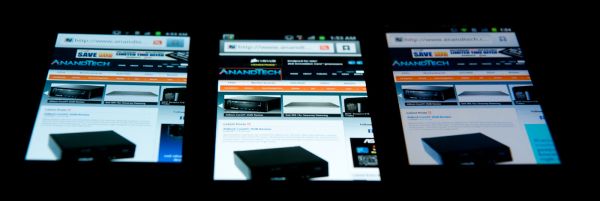






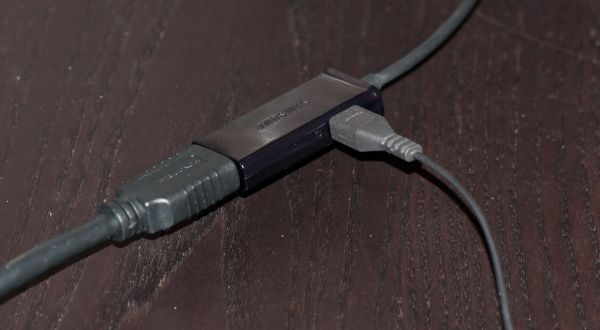
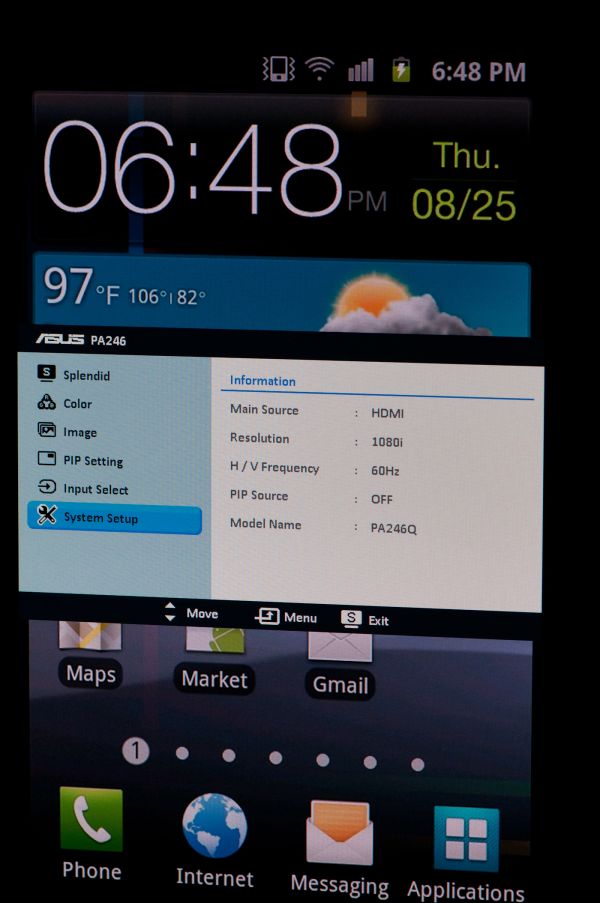








132 Comments
View All Comments
kreacher - Monday, September 12, 2011 - link
I was disappointed to see that there is no mention of the screen 's inability to display 24bit gradients while Samsung claims its a screen capable of displaying 16M colors.supercurio - Monday, September 12, 2011 - link
See my answer for Astri.Maybe you only checked a gradient in Web Browser or a specific app that forces 16bit surfaces.
Each app has the ability to choose how the rendering is done in this regard.
Internally, the Super AMOLED controller works in much more than 24bit in order to proceed to complex color-space conversions between the a digital frame buffer and an analog, very large dynamic range OLEDs.
lemmo - Monday, September 12, 2011 - link
Great review, and incredible detail on the audio quality. Shame the SGS2 has taken a step backwards on audio. Any info on the likely spec for the audio on the Samsung Nexus Prime?Also, any recommendations on reviews of best smartphones for audio quality? cheers :)
supercurio - Monday, September 12, 2011 - link
Thanks for the feedback!I really need it in order to improve next review.
Organize it differently for better readability, maybe evaluate other aspects as well (like recording)
I have no info about what's in Nexus Prime but I'd like to :P
If somebody can send me a report: https://market.android.com/details?id=org.projectv... I'll study it.
Best devices I know in terms of audio quality:
- with Voodoo Sound: Nexus S, Galaxy S family, Galaxy Tab 7".
- with or without Voodoo sound: Asus Transformer
- soon with Voodoo Sound: Galaxy Tab 10.1 (incredible power stage for the headphone amp)
- iPhones/iPad: clean DAC but boring headphone amp (unable to drive many cans to adequate levels)
And.. many I don't know! (yet?)
lemmo - Wednesday, September 14, 2011 - link
Thanks supercurio, very helpful. I'll keep looking for more info on the Nexus Prime.Shame none of the other phones/tablets you mention have got the right spec for me.
In practice, do you think the 'average user' will notice the poorer audio quality on the SGS2?
yellowchilli - Monday, September 12, 2011 - link
a very very good read thank youi've owned the sgs2 since its EU launch..it's interesting to see the slight differences/improvements samsung has put into the US release (e.g. the power button, camera ui)
mcquade181 - Monday, September 12, 2011 - link
I've had my SGS2 here in Australia for two months now and on a recent snow trip noticed some deficiencies compared to my friends Nokia N8. We both use the same provider (Telstra 3G on 850MHz):1. Whilst travelling there were periods where I completely lost reception whereas the N8 still had a signal and was able to make calls. This suggests that the SGS2 is a bit lacking in cellular sensitivity (and note that the N8 is not all that flash either when compared to the old Nokia N95).
2. In our snow accomodation I could not get a reliable WiFi signal from the local hotspot whereas the N8 could (it was marginal, but it did work).
3. Bluetooth on the SGS2 is unreliable with some devices. It keeps disconnecting after a few minutes.
That said I do like my SGS2 and is better in many other ways to the Nokia N8 - in particular earphone volume and call clarity where the N8 is deficient. Of course android has a much wider selection of available apps than does the Nokia, although surprisingly ALL my favourite apps are also available for the Nokia.
Regards from down under, Graham Rawolle.
willstay - Monday, September 12, 2011 - link
What a coincidence. After two Androids, I actually bought N8 and later sold it to get SGS2. Before Belle, swype was only available in landscape and my must-have apps are not there for Symbian.jcompagner - Tuesday, September 13, 2011 - link
yes that is the only drawback i also can find of the SGS2..Wifi reception is really not up to standards.
kmmatney - Monday, September 12, 2011 - link
I'm not happy with the battery tests - they don't show real life usage. I'd still like to know what happens with the battery if you just leave the phone in your pocket for most of the day, or what happens if you leave it in standby overnight. All of my co-workers complain about battery life with their Android phones, and all want to get iPhones the next time around. The batteries seem to drain excessively with the phones doing nothing, and they are often dead when they go to use them. Who cares if you can browse the web for 7 hours or whatever...I just want the phone to be ready to use if its been sitting on my desk for half the day, or if I forget to charge it overnight. This is way more important - at least for someone like me who travels. (actually, I work a lot in wafer fabs around the world, and crappy reception in the fabs often drain battery quickly).I guess it will depend on what Apps are installed, and you use push notifications, but it would be useful to have a test where you charge the phone, and then let it sit for 8 hours doing nothing, and then report the battery life. The older Android phones seemed terrible at this, while my iPhone 3GS is great.
This phone looks awesome, but I would need this information before I would consider buying it.